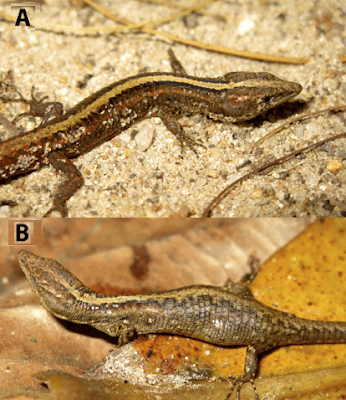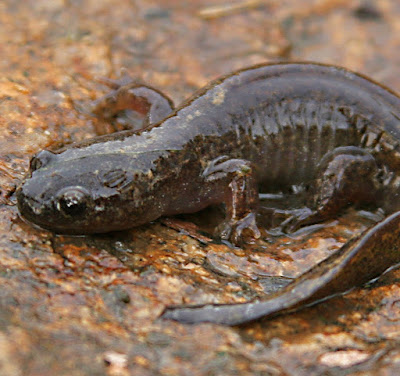[Most Recent Entries] [Calendar View]
Wednesday, September 21st, 2016
| Time | Event | ||
| 4:11a | [Herpetology • 2016] Placosoma limaverdorum • A New Species of Lizard Placosoma Tschudi, 1847 (Squamata: Gymnophthalmidae) from the Relictual Forest Mountains of the State of Ceará, Brazil
Abstract A new species of Placosoma Tschudi, 1847, until now restricted to the Atlantic Forest areas of southeastern Brazil is described based on specimens obtained about 1700 km north to the current distribution of the genus. Placosoma limaverdorum spec. nov. is apparently endemic to three “brejos-de-altitude”, relictual forest mountains surrounded by dry Caatingas, in the State of Ceará, northeastern Brazil. It differs from their congeners by the presence of an undivided transparent palpebral disk, a divided nasal scale with a central nostril, a deep tympanic recess, a distinctive and thin light vertebral stripe on the dorsal surface of the head, body and tail, femoral pores present only in males (21–26), preanal pores absent and additionally by having 21–24 rows of transverse ventral scales, 34–38 dorsals, dorsal, lateral and ventral scales smooth, dorsal scales quadrangular, longer than wide, except in the neck region, where they are wider than long. Keywords: Reptilia, Placosoma limaverdorum spec. nov., Brejos-de-altitude, Northeastern Brazil  Etymology. The species honors Prof. Dr. José Santiago Lima-Verde, an important collaborator of herpetological studies in the State of Ceará, who started the Herpetological Collection of the Universidade Federal do Ceará (CHUFC) and the Núcleo Regional de Ofiologia da UFC (NUROF-UFC). This description is also a tribute to the agronomist Wilson Luiz Lima-Verde, owner of the cottage (Sítio Olho d’Água dos Tangarás) where the holotype was obtained. Distribution and natural history. The type series of Placosoma limaverdorum indicate that the species occurs in the forested mountains of Serra de Baturité (4o05’–4o40’S/38o30’–39o10’W), and Serra de Maranguape (3o54’–4o03’S/38o32’–38o40’W) in the state of Ceará, northeastern Brazil from where it is apparently endemic (Figure 4). Another record, although without voucher (P.C.M.D. Mesquita, personal information and photo) confirm its occurrence at Serra da Aratanha (3º55’–3º58’S/38º38’–38º36’W), another nearby forest region. These areas, the called “brejos de altitude”, are forest islands isolated in the semiarid Caatingas. Placosoma limaverdorum was always found inside the forest. Most specimens were spotted on the leaf litter of the primary and secondary vegetation, or in banana plantations (Lima 2005), in sympatry with the gymnophthalmids Leposoma baturitensis Rodrigues & Borges, 1997, Colobosauroides cearensis Cunha, Lima-Verde & Lima, 1991 and Stenolepis ridleyi Boulenger, 1887. Two specimens were found in tree trunks, one on a central part of the trunk of a thin tree, about 1.3 m high, and the other in a vertical branch, about 1.2 m from the ground, between epiphytes and lichens. Three specimens were taken from the stomach contents of the snake Drymoluber dichrous (Peters, 1863) from Serra de Maranguape (Borges-Nojosa & Lima 2001). Diva Maria Borges-Nojosa, Ulisses Caramaschi and Miguel Trefaut Rodrigues. 2016. A New Species of Lizard Placosoma Tschudi, 1847 (Squamata: Gymnophthalmidae) from the Relictual Forest Mountains of the State of Ceará, Brazil. Zootaxa. 4169(1); 160–170. DOI: 10.11646/zootaxa.4169.1.8 | ||
| 9:25a | [Herpetology • 2016] Hynobius unisacculus • A New Species of Salamander of the Genus Hynobius (Caudata, Hynobiidae) from South Korea
Abstract We describe a new species of lentic-breeding Hynobius salamander from the Naro Islands, near the village of Bongrae-myeon, Goheung-gun, Jeollanam-do, South Korea, on the basis of results of morphological, ecological and genetic analyses. Hynobius unisacculus sp. nov. is distinguished from its congeners by a combination of the following morphological attributes: (1) comparatively small size (adult SVL up to 61 mm; range 38.3–60.3 mm in males and 37.5–59.9 mm in females); (2) relatively slender short limbs; tips of fore- and hindlimbs adpressed on body never meeting, but separated by a large gap (gap of -3.0 to -1.5 costal folds in males and -3.5 to -1.5 in females); (3) comparatively short tail (TL/SVL ratio in adult males varying from 0.54–0.98, in adult females from 0.55 to 0.89), tail flattened and with a low dorsal fin extending to the posterior one-third of tail length; (4) usually 11 (occasionally 12) costal grooves; (5) in adults, dark brown dorsum with indistinct bronze or dark copper spots, lighter greyish-white or pinkish belly; (6) well developed fifth toe; (7) comparatively shallow vomerine tooth series with 13–23 vomerine teeth; (8) small, pigmented ova, located in one, occasionally two, strings in a small, curved egg sac with folded envelope, lacking distinct mucous stalks or whiptail-like structures on both ends. The molecular differentiation among Korean Hynobius is high; Hynobius unisacculus sp. nov. is genetically highly divergent from the morphologically similar H. leechii, H. yangi and H. quelpaertensis: pairwise distances are 9.7%, 9.1% and 8.0% of sequence divergence at the COI mtDNA gene respectively, and 10.9%, 10.9% and 9.4% of sequence divergence at the cyt b mtDNA gene, respectively. At present, the new species is known from coastal areas and offshore islands in southeastern part of Jeollanam-do in South Korea. We suggest the species should be considered as Vulnerable (Vu2a) in accordance with IUCN’s Red List categories. Our study supports the presence of undiagnosed taxonomic diversity among Korean Hynobius. Keywords: Amphibia, Hynobius unisacculus sp. nov., H. leechii, H. quelpaertensis, H. yangi, egg sacs, lentic-breeding species, mtDNA, morphology Mi-Sook Min, Hae-Jun Baek, Jae -Young Song, Min Ho Chang and Nikolay A. Poyarkov. Jr. 2016. A New Species of Salamander of the Genus Hynobius (Amphibia, Caudata, Hynobiidae) from South Korea. Zootaxa. 4169(3); 475–503. DOI: 10.11646/zootaxa.4169.3.4 |
| << Previous Day |
2016/09/21 [Calendar] |
Next Day >> |




